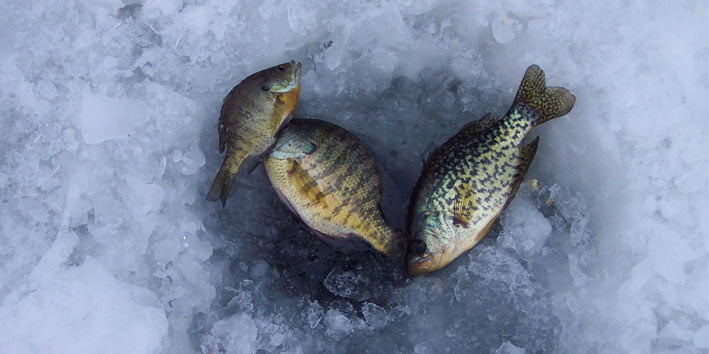You have been on your boat all-day casting the line, waiting patiently for the right opportunity. Finally, you notice the tightening of your line, and it becomes difficult to pull it back up.
However, fishing can be a frustrating enterprise. You could scout for the whole day, cast your line multiple times, change locations, and still end up with nothing.
This is why we present here exclusive crappie fishing tips.
Crappie fish come in two major species which are briefly highlighted below along with their behavioral patterns:
White Crappies
White crappies are lighter as they only have 6 dorsal spines. The colored bands on their side are usually 8 or 9. Also, though they can get by in rough waters, they are usually found in southern states with fewer waves.
The average size of a white crappie is 1 pound with 5 pounds being the extreme size.
Black Crappies
As the name suggests, they are the darker of the two species and have clearly visible spotting on the sides. In terms of water conditions, you are more likely to find them in lakes with acid content.
They are known to live with white crappies at times, but are less likely to mate with each other.
Follow these simple steps, and you can achieve a better result in your crappie fish angling:
Step 1 - Finding the Crappies
While crappies are one of the easiest game fish to score, you would not achieve optimum results if you’re not looking in the right direction. They can be found on virtually all continents, but are more prominent in North America and Canada.
They are usually not found in saltwater. Instead, they are known to flock in freshwater streams, rivers, and lakes. This is because they are freshwater fishes and the conditions of salt or sea water would eliminate their existence.
Look near broken tree branches or submersed bush chunk
Crappies don’t like being exposed to light or open atmosphere. While they enjoy the fresh or clear water, they are usually found in covered locations.
When you can’t find these conditions, you can mimic them by building artificial bush coverings around a lake. Also, you can drop three branches in a lake, leave for a few hours to a day and come back to fish at the spot where the wood was dropped.
An extra tip is to look at the space between two tree logs. This gives higher chances of finding crappies than looking at just a single branch.
Dam and docks also do the Job
This also follows from the previous clues as dock side also provides for covering that can serve well as a crappie stops for fishing.
When all else fails use fish finders
Sometimes, crappies can be difficult to find because they stay in deep waters. In this case, using a fishfinder would help locate them.
Step 2 - Use the Proper Tools
Rod and Reel
All you need is a lightweight rod and a reel. We recommend using a spinning reel as it is beginner friendly.
Bait
We recommend small jigs and and minnows. Minnows are considered the top choice if it is legal in your chosen fishing place. Always check the regulations as you could end up with a hefty fine.
Step 3 - Know How Crappies Behave:
Know how crappies react to weather conditions:
Avoid muddy waters
When the water is not clear or has particles your chances of finding crappies reduce as the mud makes it difficult for crappies to see the bait clearly.
Pre-spawn Conditions
This is a period when water temperature is at 60 degrees, and this could be either February or May depending on whether the fish are in the south or north respectively.
During this time the crappies move into shallow waters.
Spawn Conditions
This is essentially the mating period which also means egg laying time for the females. When the eggs are inseminated, the females go deep into the water, and the males protect them.
In a bid to protect their hatchlings, the males are prone to aggression at this time and bite anything in their path. Thus, a little bait set on a line attached to a pole would get you good results.
Post-spawn Conditions
During this period, they hardly move close to the surface, however, they will attack without hesitation as they have probably not fed in a while.
Conclusion
To summarize, you need to understand the kind of crappie you are dealing with. Next, you must know the positioning and the environmental preferences of this fish. Finally, you must take into account seasonal preferences and life cycle considerations.
We hope our crappie fishing tips improve your overall fishing experience while ensuring you don’t return to your camp empty handed.
